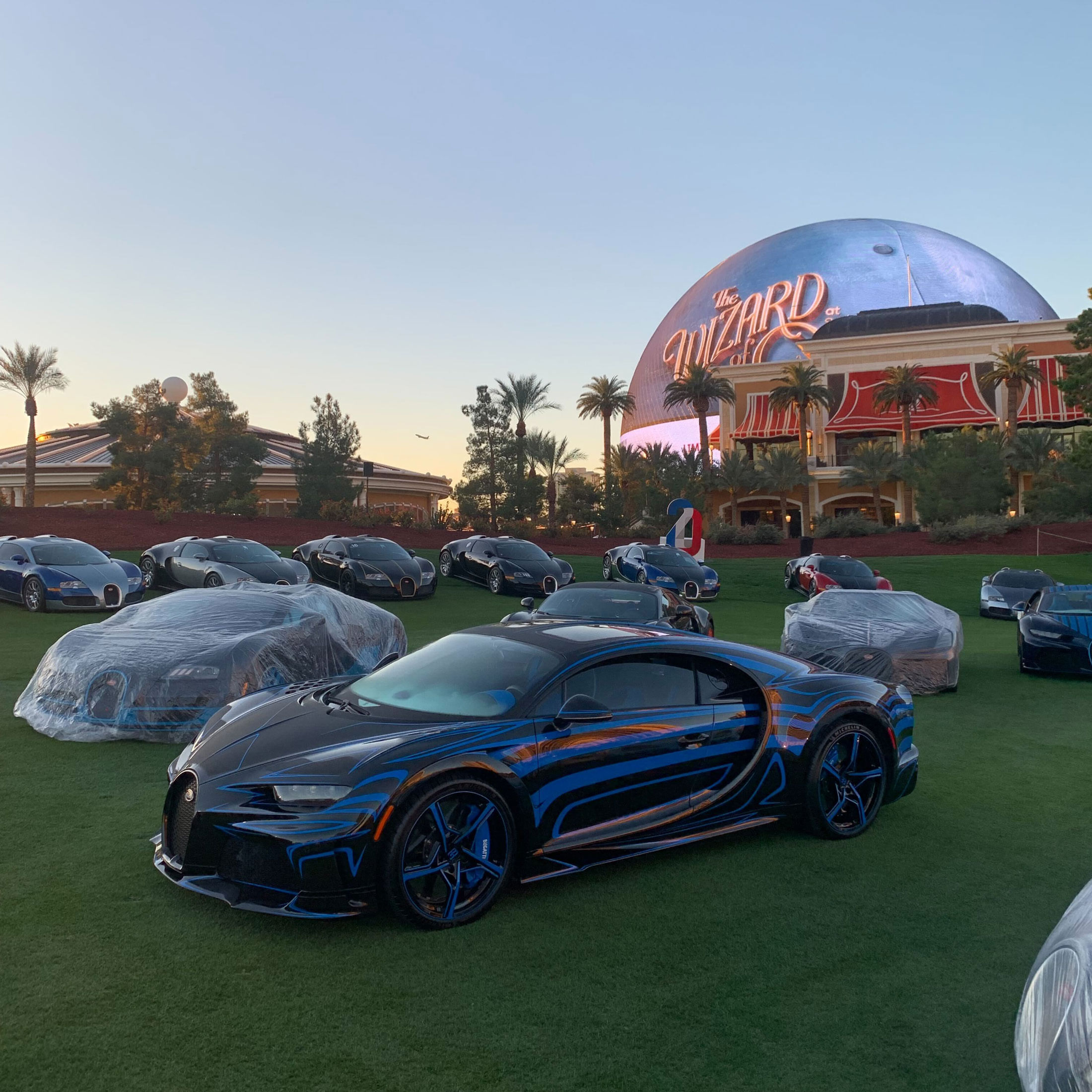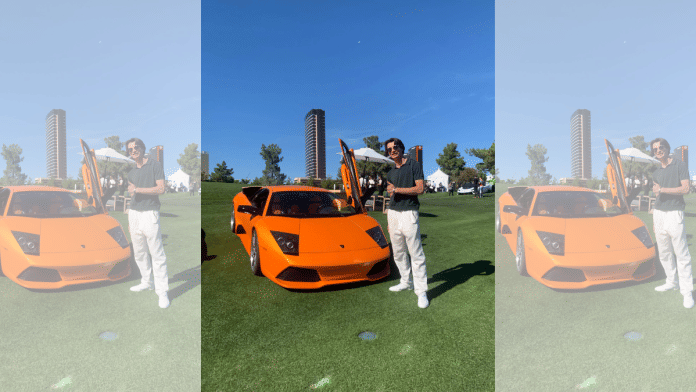Los Angeles: Jack Morris treasures his 2009 Lamborghini Murcielago LP 640. But it’s not always easy to love.
“It’s huge, it’s heavy, it’s clunky, you can’t see out of it,” says the 24-year-old of the orange V-12. “On paper, if a Porsche 911 is a good car, I would say this one is not good.” That hasn’t stopped him from putting 16,000 miles on the engine since buying it two years ago.
“It’s not going to deliver times anywhere near as fast as the newer stuff,” he says. “But I don’t care about any of that. I love it because it delivers something memorable.”
Morris isn’t alone in embracing the idiosyncrasies of supercar life. Hundreds of like-minded owners brought their Bugattis, Ferraris, Koenigseggs and Paganis to the Wynn Las Vegas on Nov. 1. The value of the vehicles entered in the 600-car concours totaled $1.1 billion, according to the Wynn.
The demographics of the owners may surprise you. Many are young, and they’re eager to actually drive their exotics rather than keep them stored with low mileage. Ask the companies that make the cars and the dealers who sell them, and you’ll hear that it’s this vibrant group of aficionados who are the reason the market seems immune to the toll of tariffs and disappointing electric vehicle sales.
“We see more customers from a younger generation approaching the hypercar market,” says Christopher Pagani, the son of the founder and head of marketing for the eponymous supercar company. “You sit all of them at the same table, and they’ll never talk about money. They’ll always talk about their passion.”
Supercars, hypercars and megacars (those with 1,341 horsepower, or roughly one megawatt) are superlative vehicles produced in tiny quantities. They often introduce advanced technologies that push them to astounding speeds — and they have the price tags to match.
The segment has grown in every way since Lamborghini debuted the 350-horsepower Miura in 1966. The first supercar, it cost around $20,000 (the equivalent of $199,000 today). By the 1990s, Lamborghini Diablos cost around $240,000 ($495,000). The 1,080hp Lamborghini Fenomeno announced in August? Try $3.5 million.
Subscribe to Bloomberg’s car podcast, Hot Pursuit! on Apple, Spotify and other Podcast Platforms.
More of them are around these days, too, even as production volumes remain low. Last year, Ferrari reported record annual sales of more than 13,700 vehicles delivered globally encompassing six main models, plus multiple special editions. In 1995, it offered just four models, including the iconic F50. Porsche makes more than 20 variants of its 911 sports car alone and delivered more than 50,000 of them globally in 2024.
Propelling the demand are all the things that get these cars criticized: Extreme styling, outlandish colors, disruptive engine noise and raw speeds.
“It’s not about how people react to the supercar — it’s about how you feel driving the supercar,” says Ron Sturgeon, a Dallas entrepreneur who brought his Bugatti Veyron to Vegas. A longtime collector, Sturgeon is not in the under-40 set, but he embraces the newcomers who he says pervade the rallies. “We need to be attracting these younger people,” he says.
Supercars are the unobtanium of the car world: Getting one requires nurturing a friendly relationship with a dealer. The more hate these cars get — as gas-guzzling markers of poor taste and unchecked excess — the more these fans love them. They celebrat them as expressions of individuality, freedom, engineering, beauty and personal success. It’s worth noting that more than a few of these enthusiasts are self-made. It took 10 years for Morris to save enough of his earnings from creating gaming videos before he could afford his car.
“What’s common is that most of them started from zero,” says Pagani.
The minute variations of such machines often blur. But the cars themselves always stand out. The extreme customization of factory-exclusive craftsmanship and aftermarket adjustments make them rolling billboards for their owners. Each one is a thumbprint with an exclamation point on top. That’s the appeal.
View this post on Instagram
“I bought it and then tore it apart,” says Nicole Villa, describing how she modified her 2017 Lamborghini Huracan for drag racing. “It’s all forged carbon everything.”
In these circles, the vibration, roar, smell, sound and feel of a combustion engine are imperative; manual gearboxes are preferred. In 2022, Koenigsegg put a manual transmission in its 1,385-horsepower CC850. The next year, Aston Martin unveiled its 705-horsepower V-12 six-speed manual Valour. On Nov. 1 on the concours lawn, Pagani debuted the Huayra Codalunga Speedster, a $7.4 million V-12 that comes with an optional seven-speed manual.
“Our customers had given us a lot of feedback on what they wanted on the future cars,” Pagani says. “Answers were you’ve got to stick with the V-12, and we want the manual transmission back.”
Such analog pleasures are what make supercars more emotional and engaging to drive than something powered by electricity. And these folks do want to drive them. Morris went so far as to convert his Murcielago to a gated shifter after he bought it. (Such shifters use a metal plate with defined slots, or gates, to physically guide the gear lever during shifting.)
“It’s a community of drivers,” says Diane Caplan, the head of marketing at Fertitta Automotive in Houston. The company quickly sold out of all of its Bugatti Tourbillon (estimated at $4 million each) allocations, she says. “Our owners love to meet each other, they have bonded, and now they’re all doing trips together driving the cars.”
The cost of such devotion involves way more than the purchase price. Servicing a Pagani costs more than $8,000; on a Bugatti it’s closer to $25,000. (The company declined to comment.) It will cost Morris $15,000 to replace his front differential, he says. At the moment, he’s opted not to do it.
Then there’s insurance. Supercars are the most difficult segment in the industry to insure, since they’re often driven by people unfamiliar with their capabilities, says McKeel Hagerty, the chief executive officer of Hagerty Inc., a media company and automotive insurance provider. Many of those folks are relatively young and have just made their first millions. The instinct is to buy a wild car, he says. But supercars are tricky to control, especially on wet surfaces. Not everyone can expect to easily insure their new toy.
“I got a call from one gazillionaire years ago,” Hagerty says. It was Elon Musk. “He had just bought his first McLaren F1.” Hagerty declined to insure the vehicle.
“Nobody knew Elon Musk back then,” Hagerty says, adding that at the time, the Tesla Inc. co-founder was sharing an apartment with a few other men. “I didn’t want to put our business on the line.”
As it happens, Musk wrecked the F1 in 2000. It would’ve been worth quite a lot today; Gooding & Co. sold one for $20.5 million in 2021. A Tesla spokesperson didn’t respond to a request for comment.

At the Broad Arrow auction during the Vegas concours, six of the top 10 lots sold were supercars made after 2006; the top seller was a 2010 Bugatti Veyron EB 16.4 Coupe that fetched a record $2.2 million. As the hammer came down, Doug Cohen, who brought his 1981 Lamborghini Countach to the concours, called supercars the most exciting segment in collecting today.
“We all have a screw loose,” he say. But he’s having too much fun to care.
Villa, in the meantime, describes her Huracan as a dream come true. She had purchased it with money saved working as a cocktail waitress in elite Vegas clubs. “I didn’t think it was really a tangible thing, but I had a plan and I went for it,” Villa says. “And now here we are.”
(Reporting by Hannah Elliott)
Disclaimer: This report is auto generated from the Bloomberg news service. ThePrint holds no responsibility for its content.
Also Read: From old and boring to bold and electric — Honda is finally rediscovering its Indian spark






